It’s the number one question people ask about riding an electric pedal-assist bicycle – “How long does the battery last?”
Range anxiety is a common concern not just for e-bikes but for the entire segment of Electric Vehicles growing in popularity the world over. As cyclists, though, we’ve come to understand our output over the course of a ride, the fuel we need to carry, and what emergency resources we can find at convenience stores anywhere in the country. With an e-bike it seems we want assurance that the pedal-assist will be there for the entirety of the ride; we don’t want a surprise bonking from the battery.
Googling the term finds scores of definitions on range anxiety:
Range anxiety is what an electric vehicle operator feels when the battery charge is low, and the usual sources of electricity are unavailable. It sparks a fear of getting stranded somewhere, which adds time, inconvenience, and stress to a journey.
Range anxiety refers to the fear that an electric vehicle or bike has insufficient range to reach its destination or runs out of charge whilst out, and thus leaves the occupants or rider stranded.
Nearly all of these descriptions highlight the scary term “stranded” though this seems mostly directed towards electric car operators. In a recent article about a new e-bike brand featured on the car enthusiast site Top Gear they offer this one significant difference between most EVs and e-bikes,
This bike still has pedals “to get back home the old-fashioned way”. That’s one way to beat range anxiety…
In our last post on the subject, A Look Inside Drop Bar E-Bikes, Bob Williams hinted at some of the testing he’s been doing while out riding his new(ish) e-bike. He bought one in February 2020 due in part that, “we were riding together less and less – she continued to go faster and me slower” He adds, “I’ve done a bunch of testing of pedal-assist boost levels and I find that with Boost 1 (Eco) set at 35% bring-it-on power and 40% peak that she can ride her ride and I can keep up and get a workout like normal. Hills over 10% grade do send me into Boost 2 (Sport) -though I have rarely ever used Boost 3 (Turbo)”
Bob and his wife Catherine are ride leaders with Portland Velo and have ridden with Cycle Oregon many times over the years. As part of their club leadership roles they help develop new ridership and with this reporting they offer us a look inside the finer detail of what our rides right here in Oregon will be like aboard these new machines.
Bob Williams, his e-bike, a Garmin and Ride With GPS
I’ve done a lot of work looking at battery use based on terrain and boost level – just to get a good sense of what’s “in the tank” versus ride type. Marketing for my bike says a routine route is approximately 80 miles on a charge. I find that this number for starters is reasonably good — but use varies substantially with grade, aid, etc. Also, I’m a heavy rider so that sucks battery, too. But what I find is what I’d call a flat route, i.e. 35′ climbing/mile or less, I can actually get 100 miles of range. And after a recent firmware update I’m now getting 110?!? The magic of algorithms I guess.
Range is an interesting and challenging number for e-road bikes. It’s not nearly as easy to quantify as say the mileage your car gets. For instance, my Creo is marketed as having an 80mile range – or 120 miles if you have the extra 50% capacity battery that fits in the water bottle holder. For a normal Portland Velo club ride, say a 35-40 mile ride with 1,200-1,500 feet of climbing, I’ve found this to be reasonably accurate as to battery use. As a recent example I did a 38 mile, 1,825’ Washington County route which took 48% battery – a range of 79.8 miles. On the other hand, I routinely see 1% battery use per mile on really flat routes and riding normal/easy (i.e. range of 100 miles). The other extreme is 10% battery usage per mile when we were climbing an extended hill that averaged 8.7% for 4 miles out of Parkdale – so, a battery range of 10 miles under those conditions.
I started testing it in more detail using the power channel on the Garmin 1000 –which measures battery use in % left during course of ride. This is available on the Ride With GPS overview graph under the “Watts” category –the black descending line you’ll see on each chart. The Creo is set up with Boost 1 at 35%/40% peak; Boost 2 60%/60%; Boost 3 100%/100%.
Battery use – Climbing Versus Flat
Charts 1 & 2 compare a flat ride (32 ft/mile climbing) with a climbing ride (100 ft/mile). The flat ride, 39 miles, used 1.0% battery per mile – yielding a range of 100 miles. The climbing ride, 36.6 miles long, used 1.86% battery per mile –yielding a range of 54 miles. The flat ride was ridden in Boost 1 (Eco) while the climbing ride was a mix of Boosts 1 (Eco) & 2 (Sport).
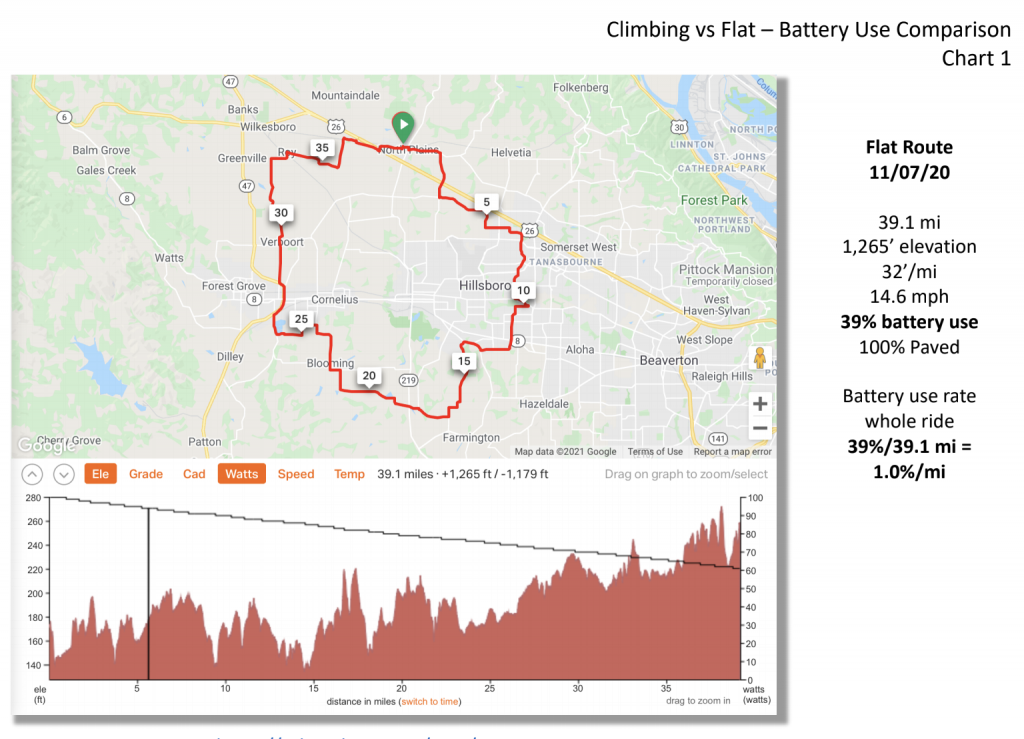

Battery Use – Same Climb, Different Modes
Charts 3 & 4 looks at the same climb –2.3 miles, average grade 4.7% -using first Boost 1 for the whole climb and then Boost 3 throughout (different days). The Boost 1 (Eco) climb resulted in average speed of 8.2 mph, took 16:37 minutes and used 8% battery – or 3.5%/mile. The Boost 3 (Turbo) climb resulted in average speed of 12.8mph (56% higher) mph, took 10.38 minutes (6 minutes less) and used 18% battery –or 7.8%/mile (133% higher).

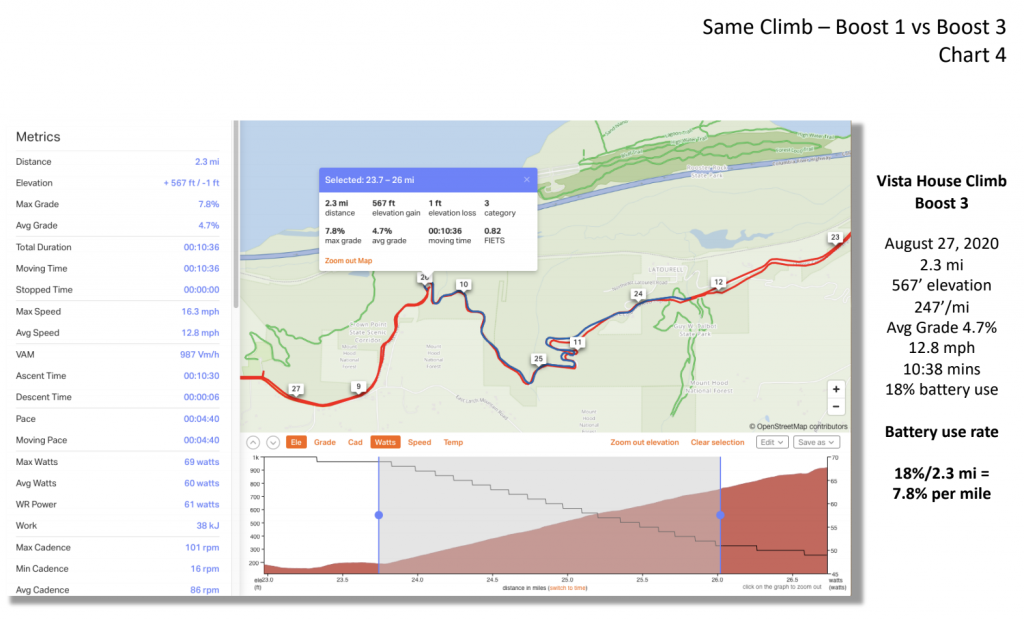
Battery Use – Paved Versus Gravel
Charts 5 & 6 look at two similarly steep routes (94’/mile climbing) with one being a mixed gravel/paved route and the other paved 100%. The mixed route used 1.72% battery/mile while the paved route used 1.6%. I was surprised that they were so close -my assumption being the gravel section would increase the battery use more.
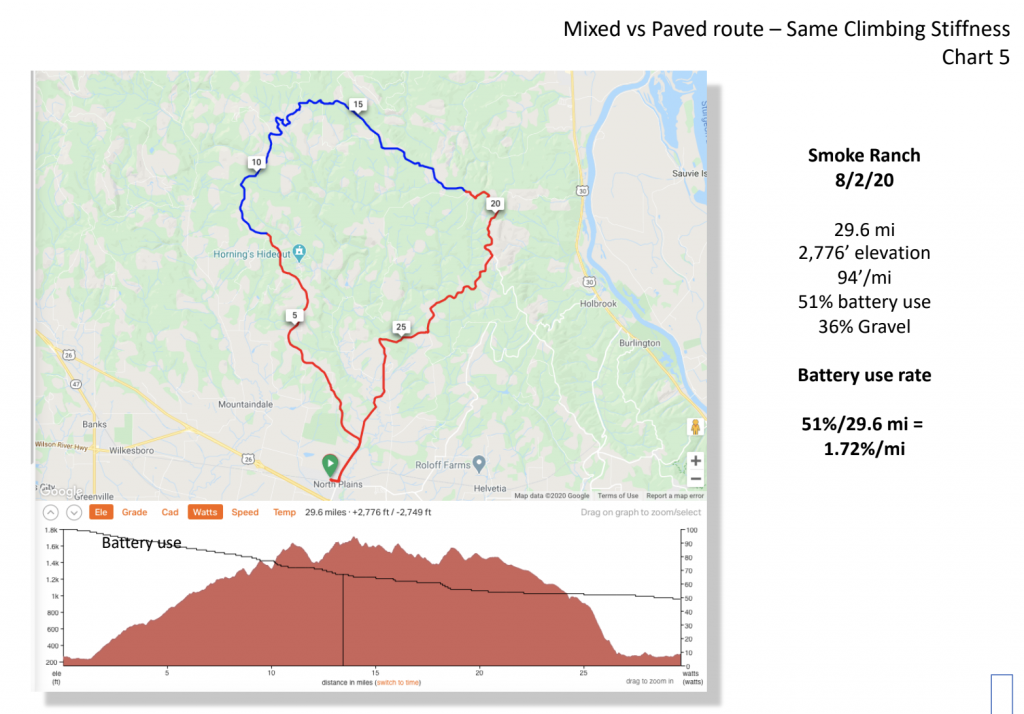
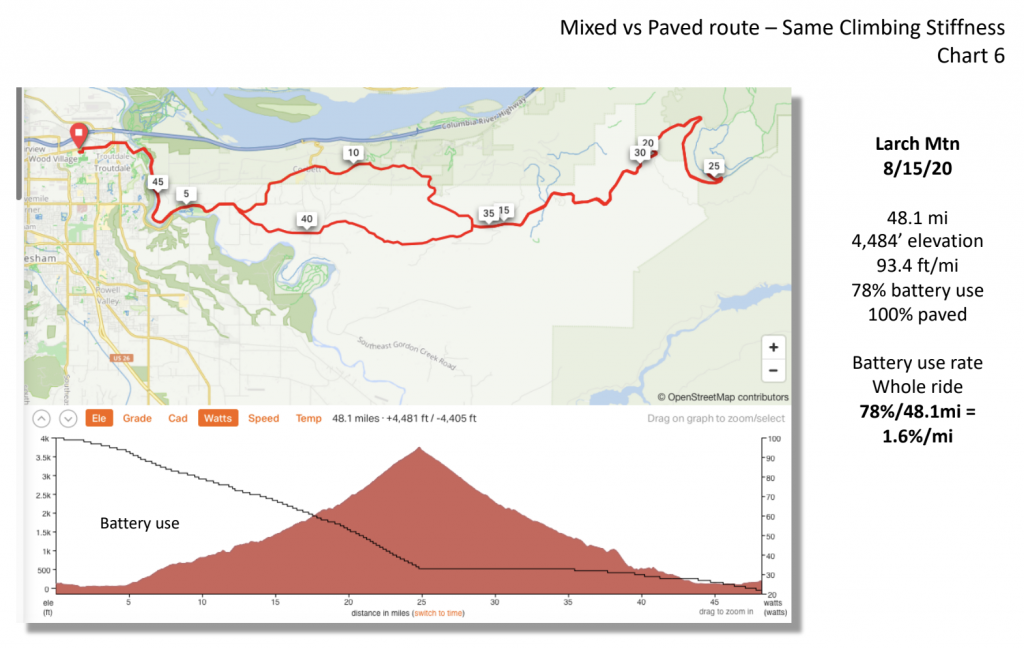
Battery Use – Paved Versus Gravel II
Charts 7 & 8 take a second look at gravel versus paved –over similar length and average grade climbs –one on Dixie Mountain Road and the other on Larch Mountain Road–8.3 miles in length, average grade 4.1% , 1,578’ climbs. Again the differences in battery use were not substantial –2.8%/mile on the paved Larch climb and 3.0%/mile on the gravel Dixie climb. This again surprised me. Speed was slower on Dixie –7.9 mph vs 8.6 mph. I didn’t track but largely in Boost 1 (Eco) for both climbs.

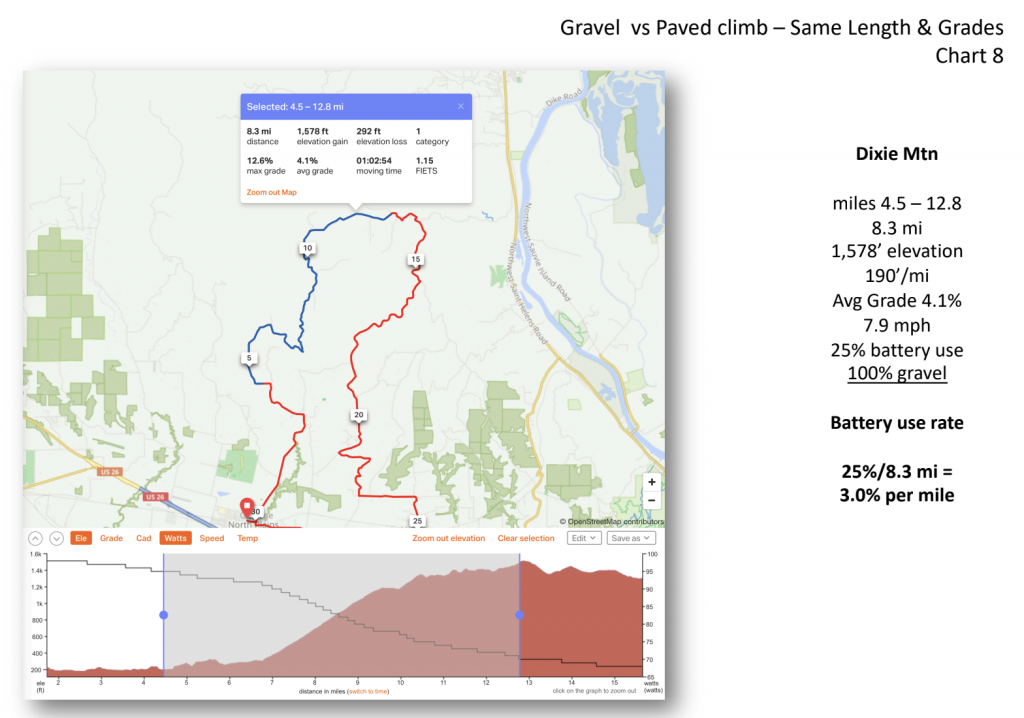
What Does It All Mean?
So as you can see lots of variability in use – mostly related to climbing intensity. My sense is that stronger/lighter climbers would have less variability (i.e. use more of their own power and less pedal-assist watts since the bike has a power meter that aims to match watt usage.)
I’ve also done some comparisons of riding/climbing on gravel versus pavement. I’ve been surprised that the differential isn’t as great as I’d expected. Still more research to do on this…
Follow Bob – On The Bike and Online
So… who wants to go on a research ride with Bob? You can see more of his rides and follow along at Ride With GPS here.
Thank you for the detailed analysis.
As an 82 year old dude, I have just acquired a Trek Domane+ and have done two significant rides. 1st was in Death Valley from Texas Springs campground to top of Daylight Pass, a 56 mile ride with 5128 ft of elevation gain. Battery died about 100meters from start point.
Just completed a 6 day , 370 mi ride with 11,968 ft elevation gain from San Luis Obispo to San Diego. Ended each day with battery at 2-3 bars (out of 5) except last day, 1 bar, cause I was rushing to pick up girl friend at airport
A secret to extending range: use the 5th level of assist: OFF!!!
For recharging at end of each day I carried a light weight charger more than adequate for overnight charging.
I look forward to doing Cycle Oregon on my eBike!
Hey Bob,
thanks so much for all of this data! Wish I lived in Or, would love to ride with you. Especially the Corvallis to Coast trail!
I bought a Specialized Vado SL gravel for my 67th Bday last January, just to try such trails. Have split 1260 ytd miles with the Vado and my Trek Madone carbon road bike owned since 2006.
Have been trying to quantify the Vado range, and your data, incl power settings, ranges, climbing rates etc are somewhat comparable to mine. I believe our bikes have the same Bosch motor?
I love the Vado as it allows me to get back to the mountains I rode & loved since the early 80’s.
These include the San Gabriel’s near my home (LA CO), incl same routes run by the pro racers in the Amgen Tour, incl Mt Baldy.
The ebike purchase became more of a necessity when my Daughter moved to Trinity Co, and my brother to the Big Sur area, both extremely rugged areas having 15-20% grades on most trails incl their driveways!
Here is some of my data on 2 of hillier/longer rides on the Vado;
46 mi Azusa Cyn to East Fork, GRR, GMR, 6100’ climbing, 5-10% grades, all paved.
15% battery left.
26 mi La Habra / Whittier hills Schbarum trail, 3650’ climbing,
5-18% grades, 1/2 dirt sgl track incl all 10%+ grades, 1/2 paved w rollers, 35% battery left.
Power use on both rides sounds similar to yours, incl dirt vs paved comparo’s. I generally use ~ :
My own power on 1-3% grades low on 4-8% grades
med on 9-14%
high on 15%+.
I have taken a few flatter rides at around 40-70’ per mile where it looks like I can get the advertised 50-60+ range, but am saving those for the road bike; just trying to gauge if I can make Mt Baldy and Crystal Lk ascents, both over 7-8000’ climbs on a sgl charge without purchasing the xtra battery!
I guess there is one way to find out, and besides it’s (mostly 😉 down hill to get home, and the Vado @37# pedals fine under 4% grade. However at 6’ 1”, 180# I’m not exactly a born climber!
To Will, Would like to know details about the “light weight” 120v charger source used for overnight charging.
I have a small car jump starter which does not put out 120 volt to charge the Bosch battery (but would start the car in the event I killed it’s battery charging the bike with a 12v inverter ; ).
Thanks again.
I rode the 2019 Oregon Classic, 7 days with my Specialized Levo Comp Mt Bike; 2.4inch knob tires. I used a 700 and 500 watt hr batteries. I was frugal, lowest level of pedal assist to compensate for friction of bike. Finished ride, loved it. Had my own generator to charge batteries at night.
Hello Bob,
I rode briefly with you in the west hills on May 30th. I have the red bike. Thanks for the analysis of battery. I’m still figuring mine out as I increase mileage and altitudes.